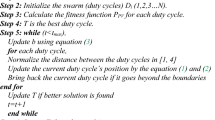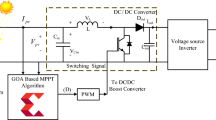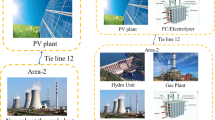Abstract
The main issue in renewable energy generating system is the variation in power generation due to the intermittent nature of the renewable sources. Due to this, voltage deviation and unexpected surges in the output voltage may affect the power system and cause unstable operation. Therefore, a power flow control of solar-wind Renewable Energy System (RES) is presented in this paper to reduce the power fluctuation and at the same time to maintain the State of Charge (SOC) of the battery within allowable limits. Initially, Maximum Power Point Tracking (MPPT) algorithm is used to operate the power system close to the peak power point. Then, the buck–boost converter with Feed Forward (FF) technique is employed to produce the response with lesser ripples. The Fractional Order Proportional Integral Derivative (FOPID) controller has the characteristics of having short rise time, reduced oscillations, or overshoot with strong robustness compared with the conventional PID controller. However, improper tuning of the controller parameters may degrade the performance of the system. Hence, we introduce a k-means Grasshopper Optimization Algorithm (k-GOA) to determine the best tuning parameters with faster convergence. In order to validate the supremacy of this technique, its performance is compared with the existing controllers like Jaya Optimization (JO) FOPID, Salp Swarm Optimization (SSO) FOPID, Chaotic Atom Search Optimization (ChASO) FOPID, Ant Lion Optimization (ALO) FOPID and Fibonacci Search Technique (FST) FOPID controllers. The outcomes show that despite sudden load changes and changes in the power generation, the power balance between the supply and demand is effectively managed by the proposed k-GOA FOPID controller. Moreover, the k-GOA has obtained faster convergence than existing optimization techniques and the converter have produced less ripples. Moreover, the proposed system has attained an efficiency of 98.5% whereas, the existing systems has obtained lower efficiency.


























Similar content being viewed by others

Abbreviations
- \( {\text{I}}_{{{\text{ph}}}}\) :
-
Photocurrent of PV cell (A)
- \( {\text{I}}_{{0}}\) :
-
Saturation current of the equivalent diode of PV cell (A)
- \({\text{I}}\) :
-
Output current of PV module (A)
- \({\text{V}}\) :
-
Output voltage of PV module (V)
- \( {\text{R}}_{{\text{s}}}\) :
-
Series resistance of the PV cell (Ω)
- \( {\text{N}}_{{\text{s}}}\) :
-
Number of PV cell in series
- \({\text{n}}\) :
-
Ideality factor of PV cell
- K:
-
Boltzmann constant (1.38 × 10–23 J/K)
- T:
-
Module temperature (K)
- Q:
-
Electron charge (1.6 × 10–19 C)
- \({\text{V}}\left( {{\text{q}} + 1} \right)\) :
-
Next output voltage of PV module (V)
- \(\Delta {\text{V}}\) :
-
Step size of P&O algorithm (V)
- \(\Delta {\text{P}}\) :
-
Oscillating power (W)
- \(\Delta {\text{V}}\left( {\text{q}} \right)\) :
-
Current step size of P&O algorithm (V)
- \({\text{P}}\left( {\text{q}} \right)\) :
-
Current output power of PV module (W)
- \({\text{P}}\left( {{\text{q}} - 1} \right)\) :
-
Previous output power of PV module (W)
- \({\text{V}}\left( {\text{q}} \right)\) :
-
Current output voltage of PV module (V)
- \({\text{V}}\left( {{\text{q}} - 1} \right)\) :
-
Previous output voltage of PV module (V)
- \({\text{I}}\left( {\text{q}} \right)\) :
-
Current ouput current of PV module (A)
- \({\text{I}}\left( {{\text{q}} - 1} \right)\) :
-
Previous output current of PV module (A)
- \( {\text{I}}_{{{\text{ph}},{\text{f}}}}\) :
-
Photocurrent at standard test conditions (A)
- \( {\text{I}}_{{0,{\text{f}}}}\) :
-
Saturation current of the equivalent diode at standard test conditions (A)
- \( {\text{I}}_{{{\text{sc}},{\text{f}}}}\) :
-
Reference short circuit current (A)
- \( {\text{R}}_{{{\text{s}},{\text{f}}}}\) :
-
Reference series resistance of the cell (Ω)
- \( {\text{R}}_{{{\text{sh}},{\text{f}}}}\) :
-
Reference shunt resistance of the cell Ω)
- \( {\text{n}}_{{\text{f}}}\) :
-
Ideality factor at standard test conditions
- \( {\text{V}}_{{{\text{oc}},{\text{f}}}}\) :
-
Open circuit voltage at standard test conditions (V)
- \( {\text{N}}_{{\text{f}}}\) :
-
Ideality factor at standard test conditions
- \( {\text{V}}_{{\max {\text{f}}}}\), \( {\text{I}}_{{\max {\text{f}}}}\) :
-
Maximum reference voltage and current
References
Abdulkhader HK, Jacob J, Mathew AT (2019) Robust type-2 fuzzy fractional order PID controller for dynamic stability enhancement of power system having RES based microgrid penetration. Int J Electr Power Energy Syst 110:357–371
Azar AT, Serrano FE (2018) Fractional order sliding mode PID controller/observer for continuous nonlinear switched systems with PSO parameter tuning. In: International conference on advanced machine learning technologies and applications, pp 13–22
Cansiz A, Faydaci C, Qureshi MT, Usta O, McGuiness DT (2018) Integration of a SMES–battery-based hybrid energy storage system into microgrids. J Supercond Novel Magn 31(5):1449–1457
Gielen D, Boshell F, Saygin D, Bazilian MD, Wagner N, Gorini R (2019) The role of renewable energy in the global energy transformation. Energy Strategy Rev 1(24):38–50
Gonzalez A, Riba JR, Esteban B, Rius A (2018) Environmental and cost optimal design of a biomass–Wind–PV electricity generation system. Renew Energy 1(126):420–430
Hekimoğlu B (2019) Optimal tuning of fractional order PID controller for DC motor speed control via chaotic atom search optimization algorithm. IEEE Access 18(7):38100–38114
Horla D, Sadalla T (2020) Optimal tuning of fractional-order controllers based on Fibonacci-search method. ISA Trans 104:287–298
Huang C, Li F, Jin Z (2015) Maximum power point tracking strategy for large-scale wind generation systems considering wind turbine dynamics. IEEE Trans Ind Electron 62(4):2530–2539
Hwas A, Katebi R (2012) Wind turbine control using PI pitch angle controller. IFAC Proc 45(3):241–246
Jumani TA, Mustafa MW, Hussain Z, Rasid MM, Saeed MS, Memon MM, Khan I, Nisar KS (2020) Jaya optimization algorithm for transient response and stability enhancement of a fractional-order PID based automatic voltage regulator system. Alex Eng J. 59(4):2429–2440
Kaouane M, Boukhelifa A, Cheriti A (2016) Regulated output voltage double switch buck–boost converter for photovoltaic energy application. Int J Hydrogen Energy 41(45):20847–20857
Khan IA, Alghamdi AS, Jumani TA, Alamgir A, Awan AB, Khidrani A (2019) Salp swarm optimization algorithm-based fractional order PID controller for dynamic response and stability enhancement of an automatic voltage regulator system. Electronics 8(12):1472
Li S, Jiang Y, Fang B, Wang C (2020) Characteristics analysis of inertia damping of grid-connected system of direct-drive wind power generation. IEEE Access 16(8):189802–189810
Lü X, Qu Y, Wang Y, Qin C, Liu G (2018) A comprehensive review on hybrid power system for PEMFC-HEV: issues and strategies. Energy Convers Manag 1(171):1273–1291
Mazouz F, Belkacem S, Colak I, Drid S, Harbouche Y (2020) Adaptive direct power control for double fed induction generator used in wind turbine. Int J Electr Power Energy Syst 1(114):105395
Mirjalili SZ, Mirjalili S, Saremi S, Faris H, Aljarah I (2018) Grasshopper optimization algorithm for multi-objective optimization problems. Appl Intell 48(4):805–820
Oladipo S, Sun Y, Wang Z (2020) Optimization of PID and FOPID controllers with new generation metaheuristic algorithms for controlling AVR system: concise survey. In: 2020 12th international conference on computational intelligence and communication networks (CICN). IEEE, pp 280–286
Oshaba AS, Ali ES, Elazim SA (2017) PI controller design using ABC algorithm for MPPT of PV system supplying DC motor pump load. Neural Comput Appl 28(2):353–364
Ozdemir S, Altin N, Sefa I (2017) Fuzzy logic based MPPT controller for high conversion ratio quadratic boost converter. Int J Hydrogen Energy 42(28):17748–17759
Park WJ, Sung BC, Park JW (2010) The effect of SFCL on electric power grid with wind-turbine generation system. IEEE Trans Appl Supercond 20(3):1177–1181
Pazikadin AR, Rifai D, Ali K, Malik MZ, Abdalla AN, Faraj MA (2020) Solar irradiance measurement instrumentation and power solar generation forecasting based on artificial neural networks (ANN): a review of five years research trend. Sci Total Environ 1(715):136848
Peng L, Zheng S, Chai X, Li L (2018) A novel tangent error maximum power point tracking algorithm for photovoltaic system under fast multi-changing solar irradiances. Appl Energy 210:303–316
Pradhan R, Majhi SK, Pradhan JK, Pati BB (2020) Optimal fractional order PID controller design using Ant Lion Optimizer. Ain Shams Eng J 11(2):281–291
Sahu BK, Pati TK, Nayak JR, Panda S, Kar SK (2016) A novel hybrid LUS–TLBO optimized fuzzy-PID controller for load frequency control of multi-source power system. Int J Electr Power Energy Syst 74:58–69
Sheikhan M, Shahnazi R, Yousefi AN (2013) An optimal fuzzy PI controller to capture the maximum power for variable-speed wind turbines. Neural Comput Appl 23(5):1359–1368
Singh SS, Fernandez E (2018) Modeling, size optimization and sensitivity analysis of a remote hybrid renewable energy system. Energy 15(143):719–731
Szczepanski R, Tarczewski T, Grzesiak LM (2019) Adaptive state feedback speed controller for PMSM based on Artificial Bee Colony algorithm. Appl Soft Comput 1(83):105644
Udayakumar MD, Anushree G, Sathyaraj J, Manjunathan A (2020) The impact of advanced technological developments on solar PV value chain. Mater Today Proc. https://doi.org/10.1016/j.matpr.2020.09.588
Ulusoy S, Nigdeli SM, Bekdaş G (2020) Novel metaheuristic-based tuning of PID controllers for seismic structures and verification of robustness. J Build Eng 33:101647
Youssef AR, Ali AI, Saeed MS, Mohamed EE (2019) Advanced multi-sector P&O maximum power point tracking technique for wind energy conversion system. Int J Electr Power Energy Syst 1(107):89–97
Zamani AA, Tavakoli S, Etedali S (2017) Fractional order PID control design for semi-active control of smart base-isolated structures: a multi-objective cuckoo search approach. ISA Trans 67:222–232
Author information
Authors and Affiliations
Contributions
All the authors have participated in writing the manuscript and have revised the final version. All authors read and approved the final manuscript.
Corresponding author
Ethics declarations
Conflict of interest
Authors declares that they have no conflict of interest.
Ethical approval
This article does not contain any studies with human participants and/or animals performed by any of the authors.
Informed consent
There is no informed consent for this study.
Additional information
Publisher's Note
Springer Nature remains neutral with regard to jurisdictional claims in published maps and institutional affiliations.
Rights and permissions
About this article
Cite this article
Aseem, K., Selva Kumar, S. Hybrid k-means Grasshopper Optimization Algorithm based FOPID controller with feed forward DC–DC converter for solar-wind generating system. J Ambient Intell Human Comput 13, 2439–2462 (2022). https://doi.org/10.1007/s12652-021-03173-1
Received:
Accepted:
Published:
Issue Date:
DOI: https://doi.org/10.1007/s12652-021-03173-1



